
California 26 Feb - 28 March | 28 March - 18 April |
France 18 April - 16 May |
Italy 16 May to 23 May
France 2 23 May - 6 June |
England & Germany 6 June - 27 June |
Cambodia 28 July - 19 August
Home |
Where in the world? |
Little Henry |
Big Al
G'day |
 There is no easy way to introduce Cambodia, so may
as well start here. There is no easy way to introduce Cambodia, so may
as well start here.This is a sequence with an imaginary monologue from the guy in the grey shirt who is loading the motorcycle.... (Click on any picture to enlarge) Pic 1: "Okay. Are you seated? You don't seem to have enough loaded on yet. We'll try this bag of flour. There should be plenty of room at the front." Pic 2: "Okay. Lean back. What's that? You can't lean back eh? Well then, breathe in. Further. Further. That's it. Wait, it's a bit tight, I'll have to change position." Pic 3: "That's better. Now I can force it down. Whoa, not that hard just there. Just a wiggle here and there should do it. What's that? A bit tight in the nether region? Slide about a bit, that should make some room. It's only a flour sack, you should be able to make an impression in it. Try thrusting forward. That's it. Comfy now?" Pic 4: "Wait on, you're not holding anything in your left hand yet. I have just the thing, a bag of dried pork skins. Just lift your grip on the handlebars. I said lift your grip on the handlebars! That's it. I'll wrap this around once and you put your hand over it again. Watch out you don't bruise it with your knee. That's it. What's that you say? I can't hear you very well." Pic 5: "I'll just check inside to see if there is anything else.... Hey, where are you going!? Well, see you drive safely." |
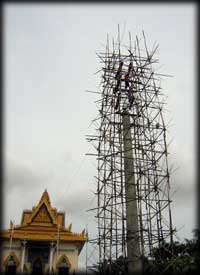 The left side of the picture
shows the top of a pagoda, also known as a Wat, which is a Buddhist temple that are very common around Cambodia,
in city and rural areas alike. Their architecture tends to the vertical - they are very tall structures. The left side of the picture
shows the top of a pagoda, also known as a Wat, which is a Buddhist temple that are very common around Cambodia,
in city and rural areas alike. Their architecture tends to the vertical - they are very tall structures.The structure on the right is the beginning of a new entrance to the pagoda. There is a corresponding one on the left, but my skills were insufficient to bring it into view. The structure of significance is the narrow vertical pipe thingy in the middle, which on completion will have a garuda (mythic bird) or similar placed on top (of each). What I find fascinating though is the scaffolding. It is mostly bamboo tied together with ropes, with the odd plank put in to stand on. The workmen (there are two on top) climb up the last part of the scaffolding without the aid of a ladder and haul up the cement and reinforcement rods needed for the pipe by a rope and pulley. I am sure the engineering for the scaffolding is probably fine, but without any steel in it at all, don't expect me to climb it! This is a work in progress visible from our front balcony, so will keep you posted on progress. |
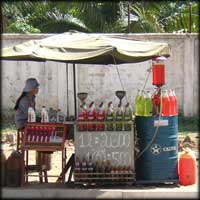 Since most of the
traffic in Phnom Penh, the capital, is motorcyclical, there is an adaption to selling petrol in small quantities,
in this case one litre. Since most of the
traffic in Phnom Penh, the capital, is motorcyclical, there is an adaption to selling petrol in small quantities,
in this case one litre.The small bottles are old glass Fanta bottles and it is a wonder that there are still enough to go around. The glass container on the 200 litre drum is a part of a pump. The glass is calibrated so that as the hose feeds into the petrol tank, the tap is closed off at the right amount. This way, you can get up to ten litres at once. The price is chalked up at 2,600 riel per litre. You can do the calculations yourself, with one US dollar worth 4,000 riel and the Aussie dollar at about 3,000 riel. |
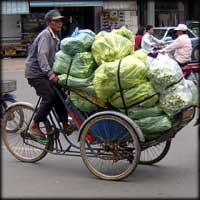 One of the main forms of
goods and people transportation that is human-powered is the cyclo, the three-wheeled cycle that has the operator
behind and the cargo at the front. One of the main forms of
goods and people transportation that is human-powered is the cyclo, the three-wheeled cycle that has the operator
behind and the cargo at the front.Underneath all that plastic is a seat for passengers. It fits one adult comfortably but can go up to three or four adults or even a family of six or seven, depending on how much you have to spend and how much you value comfort. Many of the cyclo drivers tend to be itinerants from the countryside. With a quiet time between ploughing, planting, harvesting, threshing or other farming activities, the men often come to the city to do manual labouring of some type. It does not get much more manual than this. The black bands holding down the load are strips of rubber cut from inner tubes with hooks tied at the ends. They are very strong and have a surprising amount of stretch in them. |
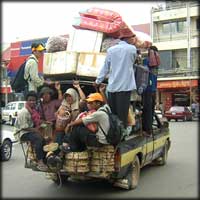 So, you thought maybe only the cyclos
and motorcycles were overloaded? Nope. This is a utility just arrived in Phnom Penh from the provinces. Pretty
much every available space has been used. Even the tailgate has been left open and the load extends over the end
of it. Seems like is standing room only for several of the passengers who have to hang on to the sides. So, you thought maybe only the cyclos
and motorcycles were overloaded? Nope. This is a utility just arrived in Phnom Penh from the provinces. Pretty
much every available space has been used. Even the tailgate has been left open and the load extends over the end
of it. Seems like is standing room only for several of the passengers who have to hang on to the sides. The driver's compartment will have either four or five adults crammed in, with two people sitting in the driver's seat - but hopefully only one actually driving. In this particular ute, the inside space on the back is seating for a dozen or so and the roof has been used for goods, but often people sit on the roof as well. This means of travelling is relatively cheap. |
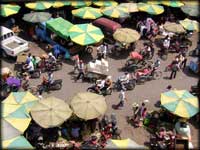 Put all
these vehicles together with a few other cars, a few bicycles and a lot of other motorbikes and numerous
pedestrians into some narrow, some wide but generally well-paved streets and you have Phnom Penh traffic.
Throw them together with unpaved streets and you have traffic of any of the towns or even the outskirts of the city. Put all
these vehicles together with a few other cars, a few bicycles and a lot of other motorbikes and numerous
pedestrians into some narrow, some wide but generally well-paved streets and you have Phnom Penh traffic.
Throw them together with unpaved streets and you have traffic of any of the towns or even the outskirts of the city.
This particular scene with umbrellas is on the edge of a market, so that the vendors spill out on to the road and take up what should be the road space. |
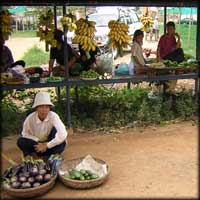 Go outside the major towns and
the market stalls are more laid back, with plenty more room. They may only have a few bunches of fruit to sell,
or a basketfull. And they are often found just along the sides of roads, not necessarily bunched together in a
formal market. Usually the location depends on the distance from home or the source of the produce. Go outside the major towns and
the market stalls are more laid back, with plenty more room. They may only have a few bunches of fruit to sell,
or a basketfull. And they are often found just along the sides of roads, not necessarily bunched together in a
formal market. Usually the location depends on the distance from home or the source of the produce.
Go to top of page |
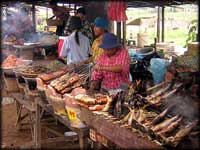 One thing you know about the food is that it is freshly cooked! You buy it
straight off the hotplate, the cooking pot or the grill. One thing you know about the food is that it is freshly cooked! You buy it
straight off the hotplate, the cooking pot or the grill.These women will sit from early morning to early afternoon tying up fish in bamboo holders and cooking them over charcoal in a smoky haze that probably isn't good for them. You have to bargain a bit too over the price. But if you don't like what you are quoted or what you see, move on to the next vendor - the price quickly comes down then as the competition can be fierce. This brings me to a feature of Cambodian selling that I have not been able to fully understand. All the vendors of much the same product, tend to be in much the same street, side by side. Thus all the sellers of silk are together in a market, as are the sellers of shoes and the sellers of books. The invites the inevitable competition that keeps prices low. Perhaps they mean just to be found, so that a buyer will know where to go in a market or a street to find, say, books or silk? |
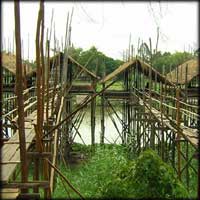 Just south of Phnom Penh
is a popular spot for relaxing on weekends called Kien Svay. Here you buy your cooked chicken or fish and bowl of
rice and some fruit to finish off, then hire a wooden hut over the water. Just south of Phnom Penh
is a popular spot for relaxing on weekends called Kien Svay. Here you buy your cooked chicken or fish and bowl of
rice and some fruit to finish off, then hire a wooden hut over the water.The huts are made of poles and planks loosely strung together so there is plenty of flex, but usually not much break. The huts have bamboo slats for floors so don't drop anything through or it's in the drink. The roof is made of thatched grass. Relax, lie back, chat, complain, eat lunch, then stretch out for a snooze. Pack up and go home. |
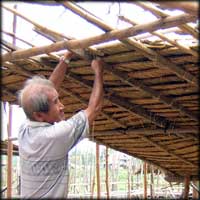 The thatch for the
roof comes in sections. About half a metre long and 30 cm wide, these sections are made by bending grass over a stick
and sewing them together with other strips of grass. The thatch for the
roof comes in sections. About half a metre long and 30 cm wide, these sections are made by bending grass over a stick
and sewing them together with other strips of grass. These sections are then put over a scaffolding of sticks in overlapping style so that the water will run off the top. They are held in place by strips of grass tying them to the scaffolding. It is an art of sorts. These sorts of structures are clearly temporary. How temporary depends on your circumstances. Building them for people to come and enjoy the countryside and the water on weekends means they might last a season, maybe two, before they have to be rebuilt. If it is your house, it may have to last for years with running repairs. Go to top of page |
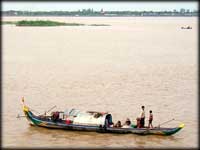 There are a lot of people who live on the rivers, particularly
the Tonle Sap and the Mekong River. They may or may not have a more permanent dwelling near the water somewhere,
but they will spend a lot of time away and sleeping in the boat. There are a lot of people who live on the rivers, particularly
the Tonle Sap and the Mekong River. They may or may not have a more permanent dwelling near the water somewhere,
but they will spend a lot of time away and sleeping in the boat.In this boat there is a man, woman and three children. The cover over midships is the only shelter. The kitchen is midships (outside, unless it is raining) and the bathroom is outside - the whole river. At the front is an oar for manouvering. It is tethered near the edge of the boat and is used in a standing position. This fishing boat is a bit sophisticated as it has an outboard motor at the back. It is a petrol engine mounted on a swivel with the propeller on a long shaft hanging over the back of the boat. The motor is started, and once the propeller is spinning, another lever mounted near the engine is used to swivel the whole motor and shaft so the propeller is lowered into the water and used for steering as well as propulsion. There is also another standing oar mounted at the back for added steerage or with use in conjunction with the fore oar. This boat uses a floating net strung about 40 metres across the river, hoping to catch something as they paddle against the current. These people always seem to me to be paddling against the tide. |
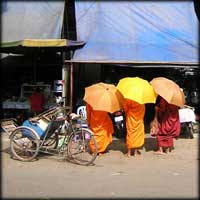 Theravada Buddhism is the
main religion in Cambodia. Similar to that of Laos and Thailand. Monks wear yellow or orange or a variation of
either robes. They eat one main meal a day at midday. They study a lot and live collectively at the pagodas. In
the early mornings they go out to collect alms. The people may give rice, other food or money, for which they
receive a blessing. Theravada Buddhism is the
main religion in Cambodia. Similar to that of Laos and Thailand. Monks wear yellow or orange or a variation of
either robes. They eat one main meal a day at midday. They study a lot and live collectively at the pagodas. In
the early mornings they go out to collect alms. The people may give rice, other food or money, for which they
receive a blessing.The monks play a pivotal role in the life of Cambodians being central to all significant ceremonies and celebrations. These range from weddings to funerals to house blessings to good luck ceremonies to opening ceremonies to coronations. Providing alms to monks is optional. Many people do not do so and the monks tend to know who will give something and who will not. But it is clear from the very good condition of the robes that plenty of people are providing for the buddhist community at the moment. Where do the monks come from? Many males in Cambodia spend time as a monk, whether as young boys or later in life. Many of them would be in their late teens and twenties. It is considered good karma to spend some time as a monk, so that even the cynical politicians do it for short periods as a publicity stunt. But a true monk, especially a teacher, is hard to beat for calmness. They exude it. |
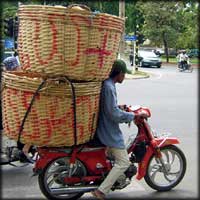 Bread is not
really all that heavy is it? Well, apparently not, as you can get two big baskets of baguettes onto one
motorcycle. Bread is not
really all that heavy is it? Well, apparently not, as you can get two big baskets of baguettes onto one
motorcycle.It is very common for bread to be sold on the roadsides at strategic exit points to the city. That way, travellers need only lean out the window of the taxi, or lean over from the back of a utility, or pull up their motorbike to get provishioned for their journey. This guy is running the bread from the central bakery out to these roadside sellers. The top basket is not tied on. It is assumed that it will not move very far, placed as it is on top of the bottom basket. But, just to be sure the rider knows where it is, he leans it forward against the back of his neck so that he can keep tabs on any movements. Also it prevents the bike from tipping backwards with too much weight at the back. His load is not covered either, though you would it expect it to be if it was raining. |
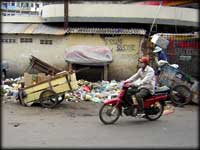 Small piles of rubbish accumulate around various
points in the city, and these do get taken away by the garbage collectors. But before they get there, it has
usually been checked by someone for any useful objects, particularly recyclable materials as someone will pay for
those - admittedly very small amounts. But some very poor people do do it. Small piles of rubbish accumulate around various
points in the city, and these do get taken away by the garbage collectors. But before they get there, it has
usually been checked by someone for any useful objects, particularly recyclable materials as someone will pay for
those - admittedly very small amounts. But some very poor people do do it.In this particular picture, the person picking the rubbish is not visible but they have left their collection cart there with their child in it. They sit among the cardboard, plastics and other objects retrieved. The picker is usually a woman and cannot leave her child at home, so must take them along with her to care for them. |
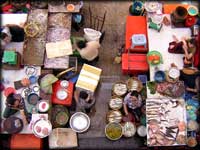 In the normal market - ie outside the supermarkets for the
more upmarket - there is no refrigeration. All goods are sold at room temperature, which in the relatively open
markets in Phnom Penh, means outside temperature. In the normal market - ie outside the supermarkets for the
more upmarket - there is no refrigeration. All goods are sold at room temperature, which in the relatively open
markets in Phnom Penh, means outside temperature.In the bottom right of this picture is a fish seller. Some of the fish are kept semi-alive in shallow water and she guts and dresses them as customers order them. But a lot of the fish will sit there for several hours in the heat before being purchased. The fish, and other vendors, such as the meat sellers, take advantage of the fresh is best principle. The cattle and pigs are usually slaughtered very early in the morning and the meat delivered fresh to the markets. It is usually sold by mid-afternoon, without any refrigeration in the process, cut up and eaten the same, or sometimes the next day. Mostly, this means that there is not enough time for the meat to spoil before being consumed. But watch out for any meats held over a day or two or more. |
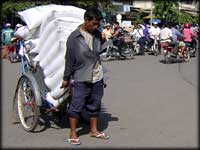 There is little doubt that the average
Cambodian leads a life of manual labour. There is little doubt that the average
Cambodian leads a life of manual labour. While not expecting to reveal this man's thoughts when I took this picture of him pulling his overloaded cyclo up a slight incline, I think I caught him at the stationary point at the top of the rise where he considers going back around to the back to mount and start peddling. But for the moment, he has stopped, and appears to be pondering greater questions. Would he be asking himself if there is not a better way to make an honest living? What sort of answer could he expect? Probably not. Has he just paused to regain some strength to go on, but on to what? Or is he exhausted and considering whether he can go on at all? Does he not wonder for how much longer he can continue to go on? |
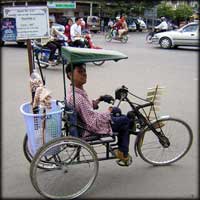 Cambodia is no
different to other countries in having a population of disabled people. But where they do differ is that there
are many more here, due mainly to either polio or landmines. Cambodia is no
different to other countries in having a population of disabled people. But where they do differ is that there
are many more here, due mainly to either polio or landmines.Landmines, that used to claim 300 people per month countrywide, but that currently claims about 120 per month. That is, some eleven years after the cessation of hostilities between Cambodians, the legacy of the landmine continues to claim limbs and lives. The second main differnce is that there is no social services structure to provide for disabilities, so it is up to the individuals, and their families, to make do. For the poor, this often means begging. This man, who has deformed legs from polio is using his initiative. He has a hand-pedalled tricycle from which he sells small packets of biscuits. He carries a sign in both Khmer and English asking people to buy his wares. He is a common sight around Phnom Penh. |
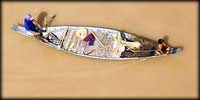 A spot of fishing? A spot of fishing?Here a man and his son fish on the Mekong River. No commercial or recreational operation this, a necessity to provide some protein for the family. |
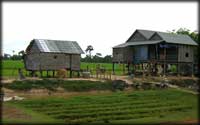 A reasonably prosperous farmer's house, situated in
the province of Kompong Cham to the north of Phnom Penh and upstream on the Mekong River. A reasonably prosperous farmer's house, situated in
the province of Kompong Cham to the north of Phnom Penh and upstream on the Mekong River.The green fields behind have been recently planted with rice and the wet season, already begun, will supply the necessary water for the growing season. |
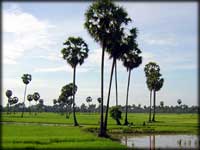 Here are some of the ricefields of Kompong
Cham. Here are some of the ricefields of Kompong
Cham.The field with water was the main ricebed where the seedlings were sown. They have all been pulled now and most of them transplanted by hand to the larger fields. The trees are sugar palms and they are climbed to harvest the palm fruit which is sold whole, or sometimes just the sugar palm juice which can be fermented to make a cheap wine. |
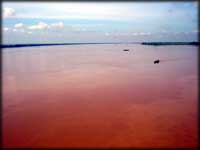 Never let it be said that the Mekong is not a
mighty river! Never let it be said that the Mekong is not a
mighty river!At Kompong Cham is a bridge across the Mekong, the closest one to its mouth, which is still several hundred kilometres to the south in Vietnam. Here the river is wide, brown and dotted with vessels of all kinds. |
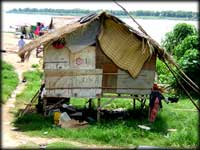 Housing in the less than salubrious riverside quarter
in Kompong Cham. Housing in the less than salubrious riverside quarter
in Kompong Cham.Made from any material to hand, including sacks, old mats, sheets of plastic, bicycle tires and bamboo poles, this square structure should be big enough for a family of five or six. |
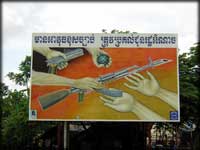 I always find this sign ambiguous. I always find this sign ambiguous.Is someone handing out free arms and ammunition, or are people handing them in? One assumes it is the latter, but what is the incentive? The writing tells people to hand in any illegal weapons to the government. This is all very fine, but the problem is not illegal weapons (whatever they are) but the number and availability of weapons. Plenty of so-called legal weapons are used everyday in crimes. And there would most often be some irony in handing over 'illegal' weapons to the government, as what are the underpaid local government authorities likely to do with them? Sell them of course! Government propaganda in Cambodia is cheap and easy to generate - get a few signs painted. |
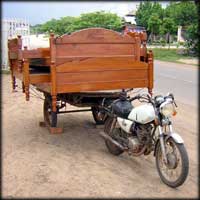 Still in
Kompong Cham, and this is the transport for a bed-making business. Trailers for motorcycles are very common.
They are called ramors. Like all other means of transport in Cambodia, some carry people and some carry goods. Still in
Kompong Cham, and this is the transport for a bed-making business. Trailers for motorcycles are very common.
They are called ramors. Like all other means of transport in Cambodia, some carry people and some carry goods.
This one is loaded down with 4 wooden bed frames. He hasn't left yet, so maybe they will load some more on. Because the motorcycles are not designed to carry these sorts of loads, they overheat after a short time. The most common method to overcome this is to have a water bottle on board with a short hose to drip water on to the engine head to help dissipate the heat. Go to top of page |
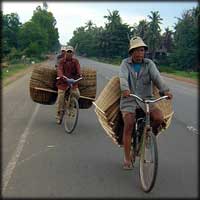 It is one thing to weave your cane baskets, it is another thing to peddle them.
It is one thing to weave your cane baskets, it is another thing to peddle them.There are two selling mechanisms. You may have a market stall to sell them to, or you may have to sell them yourself. So, what you see are travelling salesman who pedal their merchandise along the roads by bicycle. They rely on catching the eye of someone who wants to buy what they have to sell, which seems like a very hit and miss approach. |
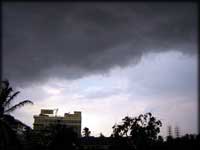 The wet season sky. The wet season sky.No, it doesn't rain every day, but probably three days in a week. Later in August and September, the frequency may go up. Usually the rain is torrential, but not always. Sometimes it is a fine rain that goes on for an hour or more. The rain comes most often in the late afternoon and it always cools things down. But of course the humidity is very high and this makes it hard to keep things for very long periods here. In the short term you have to be careful with film and anything made from leather as mould will grow on them. In the long term even things like books start to deteriorate after a couple of years, so keeping an archive of any sort must be a constant battle. |
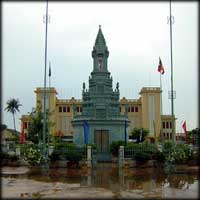 This blue stupa, here in front of the Phnom Penh railway station, is said to contain some bodily part of
Buddha, like a toenail clipping or something equally ridiculous and impossible. Why people need such
artificial concepts is hard to fathom.
This blue stupa, here in front of the Phnom Penh railway station, is said to contain some bodily part of
Buddha, like a toenail clipping or something equally ridiculous and impossible. Why people need such
artificial concepts is hard to fathom.Why, indeed, does most of the Buddhist world require some physical evidence, some physical idol to worship at all, when the Buddha spent his life teaching that such things were not only not required but actually counterproductive to the practice of true Buddhism. Buddhism is practised in the mind by the individual. By all means have schools to teach the teaching of Buddhism, but do not look outside the self for its manifestation in any other form. It lies only within. It is interesting that the day after I wrote this, I came across this quotation by Samyutta-Nikaya: - "I lay no wood for fires on altars. Only within burneth the flame I kindle." |
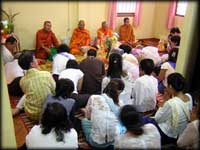 Buddhism infuses all aspects of life in Cambodia. It is integral to all major celebrations and events in
family life. Many of these celebrations are carried out in the home. These might include a ceremony for a
funeral, a wedding, a house blessing, a thank-you ceremony, homage to your ancestors or just one to bring
you good luck. This is based on the philosphy of karma whereby good actions build up your store of karma.
Buddhism infuses all aspects of life in Cambodia. It is integral to all major celebrations and events in
family life. Many of these celebrations are carried out in the home. These might include a ceremony for a
funeral, a wedding, a house blessing, a thank-you ceremony, homage to your ancestors or just one to bring
you good luck. This is based on the philosphy of karma whereby good actions build up your store of karma.Funerals in Cambodia usually require three ceremonies. The initial cremation, which is usually at a pagoda, though it starts out at the home as there are no such things as funeral parlours. Then there is a ceremony after seven days and another after 100 days. During the ceremony with the monks, they provide a blessing while the participants provide obeisance and offer food and other goods to the monks. These might include some incense for the pagoda or some new robes. Since monks are not allowed to have possessions, only their robes and begging bowls, there is little else to provide for them. This tradition is little changed in over 2,500 years. Mr Gautama Buddha certainly knew what he was about, when he founded a belief that is tolerant of all other beliefs, a belief that does not require the existence of an outside agency directing things, and a belief that has not been the source of any persecution or war or jihad in its name. |
|
|
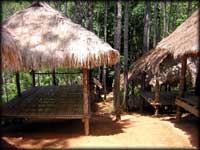 To gain some relief from the heat of the plains, you can drive 120 kilometres west of Phnom Penh to a place
in the mountains at Kirirom. Here, a couple of thousand feet above sea level you will find a camp of huts
built specifically for relaxation. Bring your lunch, or buy some things there, eat your fill and then stretch
out for a snooze before heading back to the rat race.
To gain some relief from the heat of the plains, you can drive 120 kilometres west of Phnom Penh to a place
in the mountains at Kirirom. Here, a couple of thousand feet above sea level you will find a camp of huts
built specifically for relaxation. Bring your lunch, or buy some things there, eat your fill and then stretch
out for a snooze before heading back to the rat race. |
|
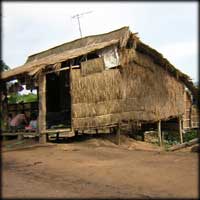 And this is the type of house she lives in. Grass thatch for the walls and roof, a raised floor of bamboo
slats and little else.
And this is the type of house she lives in. Grass thatch for the walls and roof, a raised floor of bamboo
slats and little else.Go to top of page |
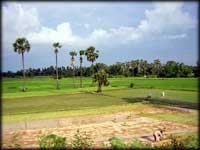 Rice planting is still going on in the Kompong Speu province west of Phnom Penh in July. Here, a woman is
working alone to transplant out seedlings in a muddy field. She has to stand in mud all day, continually
bent over to push the roots into the ground with her fingers. It is hard work. And the technique has not
changed for thousands of years.
Rice planting is still going on in the Kompong Speu province west of Phnom Penh in July. Here, a woman is
working alone to transplant out seedlings in a muddy field. She has to stand in mud all day, continually
bent over to push the roots into the ground with her fingers. It is hard work. And the technique has not
changed for thousands of years. |
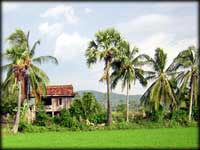 Considering the hard labour that rural people have to endure to survive, is it possible to look at their
landscape, however beautiful to our eyes, and call it paradise?
Considering the hard labour that rural people have to endure to survive, is it possible to look at their
landscape, however beautiful to our eyes, and call it paradise? |
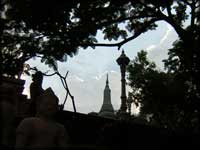 The wet season provides some overcast days and some fantastic clouds. Here the sky portends some later
rain at Wat Phnom, the only hill in Phnom Penh, if 26 metres can be called a hill.
The wet season provides some overcast days and some fantastic clouds. Here the sky portends some later
rain at Wat Phnom, the only hill in Phnom Penh, if 26 metres can be called a hill. |
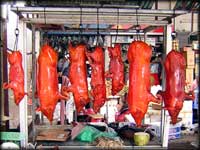 How do you like your pork?
How do you like your pork? |
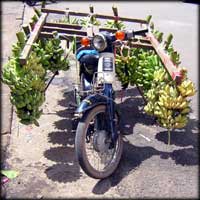 Have bananas will travel.
Have bananas will travel. |
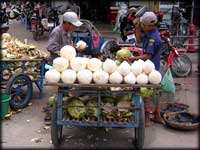 Now for some more of that coconut juice....
Now for some more of that coconut juice.... Go to top of page |
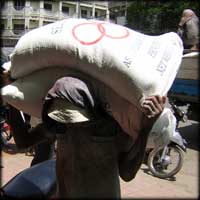 Still the work goes on.
Still the work goes on. A flour delivery to a bakery is made throught the front door of the shop on a busy street. Three men unload a small truckload of flour, picking their way through the morning customers. |
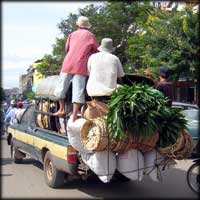 Standing room only.
Standing room only. |
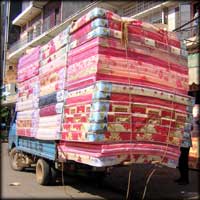 I just know there is a pea under here somewhere.... If only I could find it.
I just know there is a pea under here somewhere.... If only I could find it.Forty-four double matresses on a small lorry. |
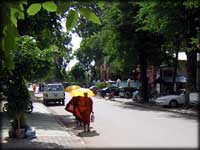 The morning rounds for alms.
The morning rounds for alms.A practice that has remained unchanged for over 2,500 years, when Goutama Buddha first instigated the colour, the robes, the practice and the order. One of the most passive of 'religions' Buddhism is probably one of the few, if not the only one, that has not caused a war in its own name, produced conflict in defence of its aims nor incited hatred in the name of its gods. In fact, Buddhism does not have any gods. The dharma (teachings) point out that one is on one's own in this world. |
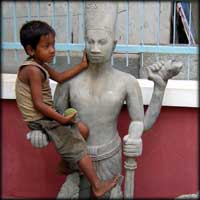 A young boy plays among the cast statues outside the National Museum workshop in Phnom Penh.
A young boy plays among the cast statues outside the National Museum workshop in Phnom Penh.Once chiselled in stone, the modern material is concrete. Go to top of page |
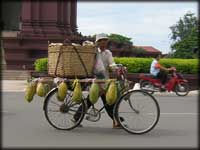 Pick your own fruit. Fresh papayas.
Pick your own fruit. Fresh papayas. |
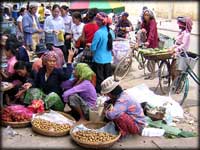 Vendors at a street market hawk fruits.
Vendors at a street market hawk fruits.This occupation is invariably for women, although older children of either gender may also sell fruit from baskets on the street. The fruit is held in large, flat baskets, which is carried on the head while mobile and is lifted down (all a skill on its own) when selling. |
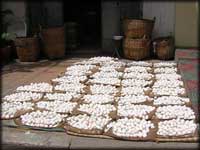 How do you like your eggs? Sunnyside up?
How do you like your eggs? Sunnyside up?Eggs put out to dry in the sun. These are almost certainly salted eggs with chick embryos in them, considered by many to be a delicacy. |
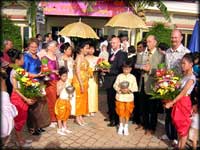 A visit to Cambodia is not complete without a wedding to attend.
A visit to Cambodia is not complete without a wedding to attend. They are colourful affairs with a lot of dressing up, a lot of music and with an endless stream of duties, such that the process usually takes all day, although the older tradition is for the wedding to take up three days. Go to top of page |
Want to send Frecko a message? Click here: frecko@large